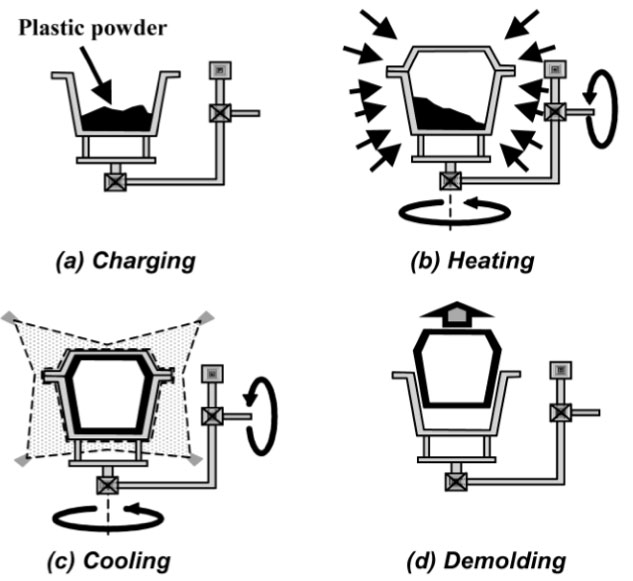
Rotational Molding Process
The rotational molding process relies on biaxial rotation and heat to form a hollow plastic product on the inside of a mold cavity.
Roto Dynamics uses a carousel rotational molding machine which has three arms. Each arm has the ability to hold multiple molds and in some cases there are 24 molds running simultaneously on a single machine. This type of machine has 3 stations:
- to load and unload
- the oven
- the cooler.
At any given time there is 1 arm in each station; one is rotating in the oven and being heated to approximately 515°F, another is rotating in the cooling station, and the third arm is having molds demolded and charged at the load and unload station. Each station has the same set cycle time and once a station is complete, all three arms rotate simultaneously clockwise into the next station.
Each arm has a set of controlled variables which include, rotation speed, oven temperature, cycle time and cooling time. Cycle times vary depending on material specification, wall thickness and mold complexity.
Product development and product optimization play a key role in reducing rotational molding process cycle times. An efficient cycle time greatly impacts the final cost and quality of the finished product.

How does the rotational molding process work?
- In Rotational Molding Process, a predetermined amount of polyethylene powder is weighed using a calibrated scale.
- At the loading and unloading station, the mold cavity is loaded with the powder. The two halves of the mold are then secured with a series of bolts or clamps to ensure the mold is sealed. This is called charging the mold. This is shown in image (a), “charging the mold”.
- The arm which the mold is mounted to then moves into the oven where it is simultaneously heated and rotated on two major axes as shown in image (b).
During the heating phase of the process, the mold becomes hot and the plastic resin inside the mold rises in temperature. As it rises in temperature it begins to stick to the inside of the mold cavity in layers creating a uniform layer of plastic.
- Once the plastic resin has formed on the inside of the mold cavity, the arm moves from the oven to the cooling chamber where the arm is cooled with a combination of air and a fine mist of water. Image (c) shows this process. Even cooling is critical, as this has an impact on the parts dimensional stability. The temperature of the plastic resin decreases below the crystallization point at which point it has partially cured.
- Once the mold has cooled, the arm moves from the cooling chamber to the loading and unloading station. The mold lid is unbolted and the finished part is removed as shown in image (d). The mold is then prepared for another cycle.
**Some rotational molding companies use different types of equipment. However the cycle follows the same principles and methodologies. On this site you can find more information about the different types of rotomolding equipment.

